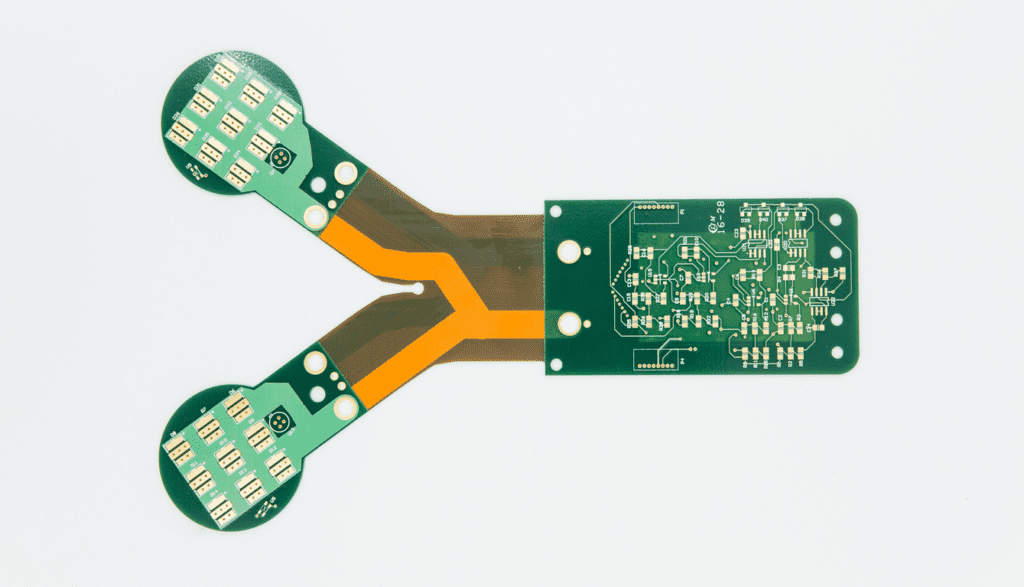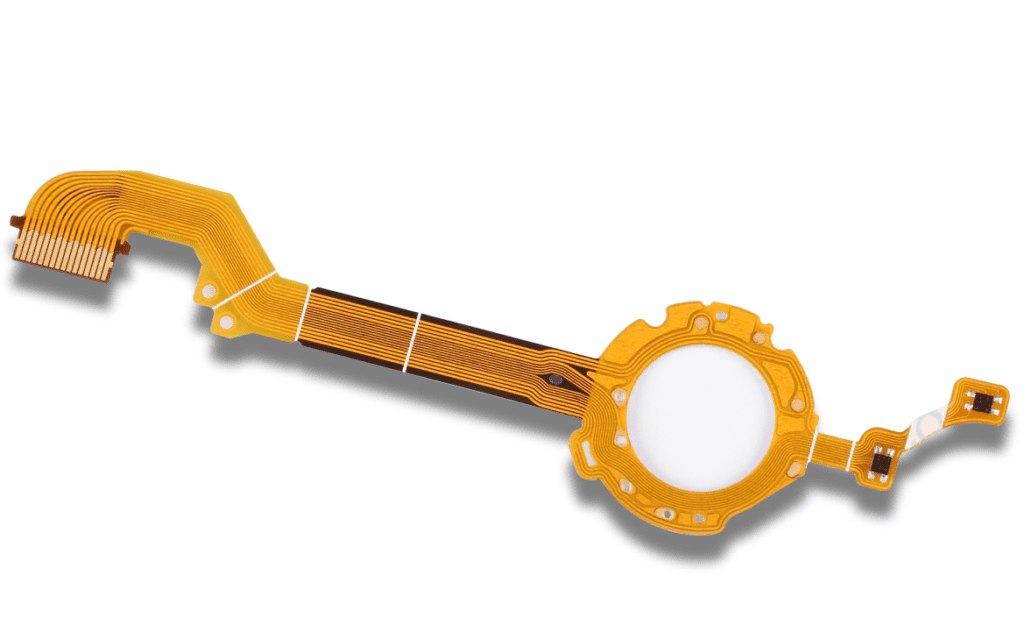PCBs or Printed Circuit Boards are an essential component of most, if not all, electronics we utilize. You can find PCBs on phones, watches, Televisions, and so much more. Moreover, Printed Circuit Boards come in varying types, which include single-layer, multi-layer, flexible, rigid, and rigid-flex PCBs. Each of these PCBs has unique functionality and is efficient in their respective application fields.
However, out of the many PCB variations, the rigid-flex, which technicians sometimes call the hybrid PCB, tends to be a special type of circuit board. Firstly, this PCB is unique due to how it is built physically, as it bears both rigid and flexible substrates. Moreover, as the name implies, it bears the characteristics of both a flexible and a rigid PCB.
However, though this hybrid PCB bears multiple advantages, manufacturing it can be a real challenge for many PCB manufacturers, whether it is a rigid flex prototype or a functional PCB. For starters, when dealing with this PCB, it is crucial to consider how design decisions may affect costs while retaining dependability early on in the designing phase. Moreover, it would help if you also considered that this PCB carries both the advantages and disadvantages of a rigid and a flexible PCB. But are these the only features that make rigid flex PCBs unique?

Rigid-Flex PCBs in a nutshell
As this circuit board’s name implies, a rigid-flex PCB is a circuit board that is a combination of a flexible PCB and a rigid PCB. That means that this circuit board has some parts that are flexible and other parts that are rigid.
The production process of a rigid PCB tends to mimic that of a regular hardboard circuit. However, technicians make some of the board’s layers flexible during production. These flexible circuits then run through the previously made hardboard PCB, generating a flex PCB. The board manufacturer will next add plated THT holes to join areas of the rigid-flex circuits with layers of the stiff circuit. This combination provides a rigid Printed Circuit Board that folds efficiently to become a small space efficient product. However, as per application, this PCB function similarly to hardboard PCBs.
Rigid-Flex PCBs are appropriate for dynamic, flexible applications which involve continual bending. Moreover, a rigid, flexible PCB that is well-built can easily sustain thousands of flexible cycles without breaking off. In either scenario, the stiff and the flexible substrates come together to produce a single integrated piece that may be further worked on to create a 3D subassembly.
Difference between Rigid-flex PCBs and Flex PCBs with Stiffeners
People sometimes utilize flex PCBs with stiffeners as substitutes for rigid-flex PCBs. Due to this reason, it is crucial for you to know the difference between the two to avoid confusing them in the future.
For starters, during PCB production, flex PCBs with stiffeners provide some stability for mechanical and assembly purposes. However, these PCBs tend to be limited in terms of where various components can be connected. Therefore, if your project requires your PCB to have a high component density, then you should opt to utilize the rigid-flex PCB.
As a result, PCB designers check on the component density to make proper decisions when stuck with an option between rigid-flex and flex PCBs with stiffeners. Doing so can save you a lot of trouble.
As component levels rise, flexible PCBs with stiffeners hit their component density limit pretty fast, making rigid flex a more appealing solution to many technicians.
Moreover, rigid-flex PCBs tend to simplify the circuit board assembly process while at the same time offering circuit routing and higher component densities. Therefore, most people favor rigid-flex PCBs. When you ignore the component density factor, you will find that flex PCBs with stiffeners are less expensive.
On the other hand, rigid-flex PCBs tend to be pretty expensive due to a couple of reasons that, include:
High-reliability
Connectors with flex cables tend to be more prone to malfunction when exposed to conditions with extreme or recurrent shock or strong vibrations. However, rigid-flexible PCBs offer excellent dependability even when exposed to severe vibrations and stressful applications. Hence, making them more reliable when you compare them to flex PCBs with stiffeners.
High Density
Sometimes it takes work to fit all the connectors and connections that a PCB designer would need into a compact enclosure. In this situation, rigid-flexible PCBs come in handy as they offer significant space-saving functionality due to their ability to fold up into compact profiles.
Rigid-flex Boards consist of Five or even more Rigid Circuit Board Connections
If you plan on utilizing five or even more PCBs on your project, then using a Rigid-Flex PCB will save you a lot of money. That is because using rigid-flex PCBs allows you to easily merge various PCBs without adding additional cables. Doing so, you will be able to save a lot of money and also space.
Rigid Flex PCB Design Guidelines
Broadly speaking, the flexible circuit substrates of rigid-flex PCBs completely extend into rigid parts of the circuit board, making these PCBs pretty similar to regular hardboard PCBs. Moreover, similar to the regular hardboard PCBs, rigid-flex board fabrication packages include:
– Drill files
– Gerber Layers
– Solder mask layers
– Nomenclature
– Cover layer
– Route/perimeter files
However, some differences exist between hardboard and rigid-flex PCB fabrication packages. These differences include the following:
Dimensions
Since technicians typically utilize these circuit boards in 3D applications, rigid, flexible PCBs should bear more dimensions than regular hardboard PCBs. Additionally, design files should accurately specify the places where rigidness and flexibility transition. That is because, during PCB production, technicians tend to have an issue when the files do not bring out the transitioning areas with great precision.
Material Layup
In rigid-flexible PCBs, the material layup is crucial and hence should be determined in cooperation with your fabricator. Moreover, your PCB fabricator assists you in selecting the appropriate materials based on your needs, which might include:
– UL flammability ratings
– Minimum bending radii
– Mechanical consideration
– Impedance control (applies for both the rigid and the flexible layers)
– RoHS Certifications
– Lead-free PCB assembly compatibility, et cetera
Layers
When you compare the Gerber files of a Rigid-flex PCB and that of a standard hardboard PCB, you will realize that rigid-flex PCBs require more layers.
Layer X and one will bear the solder mask layer, as usual. However, you will require an artwork layer that will define the following:
– The bondply section and
– The cover layer of the PCB
Rigid Flex PCB Usage
Rigid, flexible Printed Circuit boards provide a pretty vast array of circuit board applications which range from applications in digital cameras to cellphones and smart devices. Moreover, rigid-flexible PCBs have multiple application areas in the medical industry, which include:
– Utilization in pacemakers
– Utilization in hospital monitors, et cetera
Additionally, these PCBs also come in handy when technicians are developing smart control systems. Making them pretty useful in the electronics industry.
In producing consumer goods, rigid-flexible PCBs do not just maximize weight and space utilization. They also improve the performance and reliability of the product by eliminating excessive cabling and multiple solder joints.
These examples scratch the surface regarding the application areas of rigid-flex circuit boards. That is because these PCBs can be utilized to benefit almost, if not all, advanced electrical appliances applications, which include:
– Automobiles
– Testing equipment
– Modern electrical tools
Benefits of Rigid Flex Printed Circuit Boards

Space
By applying the three dimensions features when working with a rigid-flex PCB, you can efficiently save a lot of space while still maintaining a functional PCB. Moreover, using this tip, you can minimize the board’s package size, reducing shipping fees.
Connection Reliability
Rigid Flexible PCBs have fewer solder joints when you compare them to other PCBs. They, therefore, assure higher and more reliable connections.
Simple Assembly Process
Rigid Flex Printed Circuit Boards have a simplified circuit board assembly process. Therefore, manufacturers can produce many of these PCBs without the fear of messing up the production process.
Integrates ZIF
Rigid Flex Printed Circuit Boards integrate ZIF contacts which help them provide a more straightforward modular interface.
Low Cost of Production of Rigid-flex Boards
Though rigid PCBs are a bit more expensive than flex PCBs with stiffeners, their production process is relatively inexpensive. When you look at the production process logistically, you will find that these boards drastically reduce the cost of PCB production even though they are pretty efficient.
Increasing Product Complexity
Using a rigid Flex Printed Circuit Board, you can easily boost the complexity of your board’s mechanical design. Moreover, using this trick, you can quickly generate a functional solution with minimal cabling and board weight.
Rigid Flex Assembly is easier to Handle
When you compare flex PCBs with rigid boards, you will find that rigid-flex PCBs are much easier to handle during the assembly process.
Simplified Test Conditions
When working with rigid-flex PCBs, you will have a smooth time during the testing phase. That is because technicians can easily manipulate the board without breaking it due to its rigid-flex characteristics.
Conclusion
Rigid flexible Printed Circuit boards, though complicated to manufacture, are undoubtedly pretty crucial to the PCB world. Moreover, as the world is advancing to smaller powerful gadgets ranging from small smartphones to tiny wearable, these PCBs are proving to be pretty beneficial. Therefore, we hope this article has helped you learn more about rigid-flex PCBs and why you should try them out to see their power.


